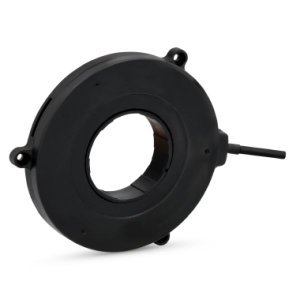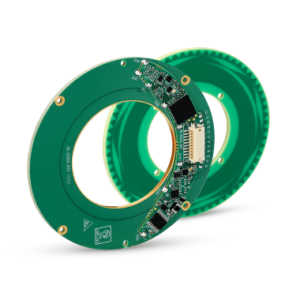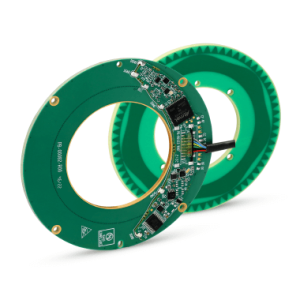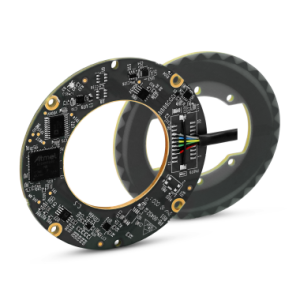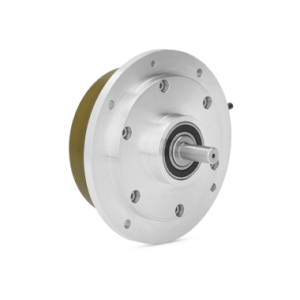Technical support
FAQ
-
The Electric Encoder technology is in fact based on variable capacitance, which has been considered sensitive to temperature, moisture, noise pickup, etc? How can it claim the opposite?
Some variable capacitance sensors are indeed quite sensitive to one or more of the above.
However, the Electric Encoder™ breakthrough which was made in the context of defense
applications has demonstrated the opposite and its superiority has been demonstrated in a
wide range of applications besides defense. It is covered by several basic patents and relies on a
continuous development effort since 1994. -
How does the Electric Encoder™ differ from the incremental, pulse counting, or other logic level output, optical encoders?
The Electric Encoder™ provides the absolute position and its continuous, exceptionally smooth
output signals proportional to the SIN and COS of the measured rotary (or linear) displacement.
Rather than directly encoding the displacement it leaves the encoding task to the A/D converter
and software optimized for it. -
Is it similar to optical Sine/Cosine encoders?
Only in providing high resolution, but there are three main differences: its “holistic” nature (see
technology section), its much lower profile and its significantly simpler, more durable,
construction. Also it has significantly less electric cycles per revolution (EC/R). -
Is the output of the Electric Encoder™ absolute?
Yes, the output signals convey the absolute rotary (or linear) position without any movement.
-
How else does the Electric Encoder™ differ from the optical Sine/Cosine encoder?
Thanks to the relatively low number of EC/R the output signals are confined to the low end of
the frequency spectrum and are less prone to errors due to PWM noise.
The absence of temperature, or time, degradation mechanisms ‐ ball bearings, LEDs, etc.
virtually eliminate any failure mechanisms. -
Is it also unique mechanically?
Yes, the rotary Electric Encoder™ high accuracy is exceptionally unaffected by shaft eccentricity
and tilt, as in high accuracy optical encoders, and therefore needs no bearing of its own for
aligning the rotor relative to the stator, as a result it is directly mountable on the host shaft. The
absence of internal bearings not only makes its profile low, but also obviates the need for a flexible shaft coupler, or flexible stator mounting, as a result the Electric Encoder™ provides both accuracy and compactness. -
Is it similar to the Inductosyn® ‐ which in essence is a printed resolver?
Yes, it is indeed similar to the Inductosyn®, which also has a “holistic” rotor, flat construction, and very high accuracy. However, it has a number of additional advantages:
- It consumes much lower power (in fact lower than any other position encoder)
- It needs no slip‐rings, or rotary transformers
- It is much lower in weight
- It includes all of its support electronics on‐board
- It is insensitive to magnetic fields and has no magnetic signature
-
Is it suitable for space applications?
Yes, the following advantages make it space compatible:
- Low weight
- Low profile
- Low power consumption
- Wide temperature range
- Mechanical robustness
- Low outgassing
- Vacuum compatibility
- High reliability
- Radiation tolerant
Netzer Electric Encoder technology is currntly incorporated in several space related systems.
-
What actually happens inside the rotary Electric Encoder™?
An internally generated space/time modulated electric field interacts with a rotor which is made of a dielectric composite material. The rotor includes a peripheral sinusoidally shaped 3D pattern that serves the Fine channel, and a recessed sinusoidal pattern that serves the Coarse channel. The electric field is integrated over the full rotor area (hence “holistic”) and the resulting signal is processed and separated into Sine and Cosine output channels. Since a common channel processes both the Sine and Cosine outputs they are nearly matched and the decoded angle is stable over time and temperature.
-
What is the resolution of the Electric Encoder™?
The inherent resolution is virtually infinite, because of the continuous outputs. In practice, the resolution in bits/360° is N+M+1 where N is the binary representation of the number of amplitude quantization steps in the A/D converter and M is the binary representation of the number of Fine channel EC/R.
-
How does the Electric Encoder™ perform over temperature?
The operating temperature range may reach ‐55º C to +125º C (it can be extended to +150º C for short periods). The main reasons for this robustness are:
1. The “holistic” rotor averages out the effects of minor mechanical deformations that occur at extreme temperatures
2. The common processing channel for the Sine and Cosine signals. This makes electronic components tolerances and stability nearly irrelevant
3. The immunity to internal offset voltages due to AC operation. -
What about repeatability and accuracy?
The output reading will repeat itself to within +/‐ 1/2 LSB, either for position move‐and‐return or power‐up. The accuracy increases as the number of EC/R increases. With properly corrected parameters an error as low as 10 arc seconds or below can be achieved.
-
What is the MTBF of the Electric Encoder™?
The Electric Encoder™ is made of special polymer and includes low‐power electronics (typically less than 50mW power consumption). It does not include components such as bearings or LEDs. Therefore, it has virtually no failure mechanism.
-
How about RFI emissions?
The Electric Encoder™ conforms to CE directives.
-
How about RFI/EMI susceptibility?
The Electric Encoder™ is inherently immune to magnetic fields, internally shielded from electrical fields, and is also insensitive to RFI as evidenced by many defense applications.
-
How does the Electric Encoder™ perform in shock and vibration environment?
Very well, since it integrates signals over the entire rotor area, averaging out vibration effects. It is being used in demanding defense applications.
-
What is the Electric Encoder™ about?
In Electric Position Sensing angular displacement influences a patterned electric field that is continuously measured to provide position feedback. This technology can be regarded as a rare breakthrough where practically every imaginable performance parameter improves, compared with existing technologies at no compromise.
-
What does "holistic" encoder mean?
The Rotary Electric Encoder™ uses the whole physical area of the rotor at any time, unlike the optical encoder that uses only a small section of the rotor. In addition, the sine and cosine output signals are generated and processed in a common channel and are very pure and tightly matched. The result is insensitivity to mechanical assembly, vibrations and installation errors as well as to temperature and contaminant effects. Contrary to logic, the correlation between high measurement accuracy and construction precision is no longer valid.
-
What is an ECR?
The number of Electrical Cycles per mechanical Revolution that the electric encoder provides as an output.



